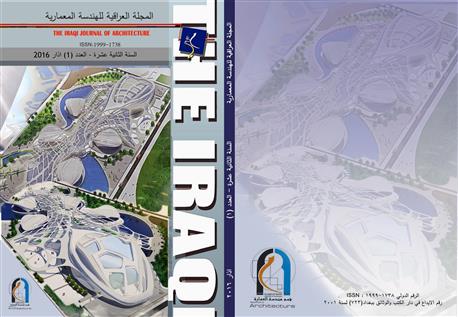Effect Of The Double Walls On Thermal Internal Environment Of Buildings In Baghdad
Abstract
the external walls represent one of the most important structural elements that have a direct effect on the thermal performance of the building.In order to achieve the aim of the research the experimental approach and style of analytical study were adopted. The current study included two main aspects: first, the theoretical side: Which included the time delay factor calculation and cooling load depending on the Radiant Time Series (RTS) theory that achieved accurate and detailed results and ease of application. While the second aspect included the practical test and measurement .The theoretical results achieved good convergence with practical results margin 22.3% increase at the expense of the electric power. Results of the study showed that the Exterior cladding material with large mass by using perforated brick of 120 mm thickness recorded the highest proportion of the economy in the amount of electric energy which considered to be the best thermally. However, Exterior cladding material (such as black Marble) and cladding materials with fewer block (such as composite- panel) represent the worst thermal performance because they made the lowest economic proportion of the amount of electric power . As well as, concluded that increasing the thickness of cavities from 25mm to 100mm may reduce the consumed amount of electric power about 4.3% .
Downloads
References
- دور الواجهات ÙÙŠ تØقيق الراØØ© الØرارية.
" http://www.cpasegypt.com/pdf/MonaElwazer/Ph.D/003.pdf
- “Alucobond Product Information†http://www.alucobond.com.au/uploads/news/id30/Alucobond_product%20info_0711.pdf
- ASHRAE, “Handbook of Fundamentals -chapter18â€, Atlanta, American Society of Heating, Refrigerating, and Air-Conditioning Engineers, Inc, 2009.
- Harkness Edward L.& Mehta Madan L. “Solar Radiation Control in Buildingsâ€, Applied Science Publishers LTD, London, 1978.
- Kannamma, “Optimizing Heat Gain By Building Materials Through Landscape Elementsâ€, International Journal Of Management, IT And Engineering, Volume2, Issue5. http://www.ijmra.us/
- Maghrabi, Amjed. A. “Comparative Study of Thermal Insulation Alternatives for Buildings-Walls and Roofs in Makkahâ€, Department of Islamic Architecture, College of Engineering &Islamic Architecture,Umm Al-Qura University, 2005.
- Markus & Morris “Building, Climate and Energyâ€, Pitman Publishing L.T.D London, (U.K), 1978.
- التميمي ,اØمدهاني رشيد, "الاثر الØراري لانهاء جدران المباني الخارجية ÙÙŠ المناخ الموضعي للبيئة الØضرية", رسالة ماجستير, قسم الهندية المعمارية, الجامعة التكنولوجية, .2013
- الجودي, خالد اØمد, "مبادىء هندسة تكيي٠الهواء والتثليج". كلية الهندسة, جامعة البصرة, 1986.
- شنيارة, د.بول "اختيار مواد البناء والاكساء من خلال مواصÙاتها البيئية", مجلة جامعة دمشق, العدد الثاني, 2002.
- نشرة المنشأة العامة لصناعة الكونكريت الخÙي٠–وزارة الصناعات الخÙÙŠÙØ© –بغداد – العراق -1984
- يوسÙ, نيÙين يوس٠عزمي, "الجزر الØرارية ÙÙŠ المدن المصرية", وقائع المؤتمر الدولي الاول للعمارة, "الماضي والمستقبل ÙÙŠ العمارة", كلية الهندسة-جامعة مصر للعلوم والتكنولوجيا, 2010.
You are free to use the work, but you have to attribute (refer to) the work in the manner specified by the author or licensor (but not in any way that suggests that they endorse you or your use of the work).
IRAQI J. ARCHIT & PLANN grants you the right to publish the metadata of the journal, it's issues and articles under the terms of the Creative Commons Attribution-ShareAlike 4.0 International License.
Author(s) hold the copyright of their aricles without restrictions. However, IRAQI J. ARCHIT & PLANN holds publishing rights for articles and their revisions once the article is published.
Authors can archive pre-prints (ie pre-refereeing) and post-prints (i.e. final draft post-refereeing) versions of the work they submitted to IRAQI J. ARCHIT & PLANN using non-for-profit open-access servers whether on author's personal website and/or institutional repositories including the university or research center where the author work.. For post-prints, only the IRAQI J. ARCHIT & PLANN’s as-published PDF version is permitted and the published source (IRAQI J. ARCHIT & PLANN’s website) must be clearly acknowledged within the archiving webpage.






